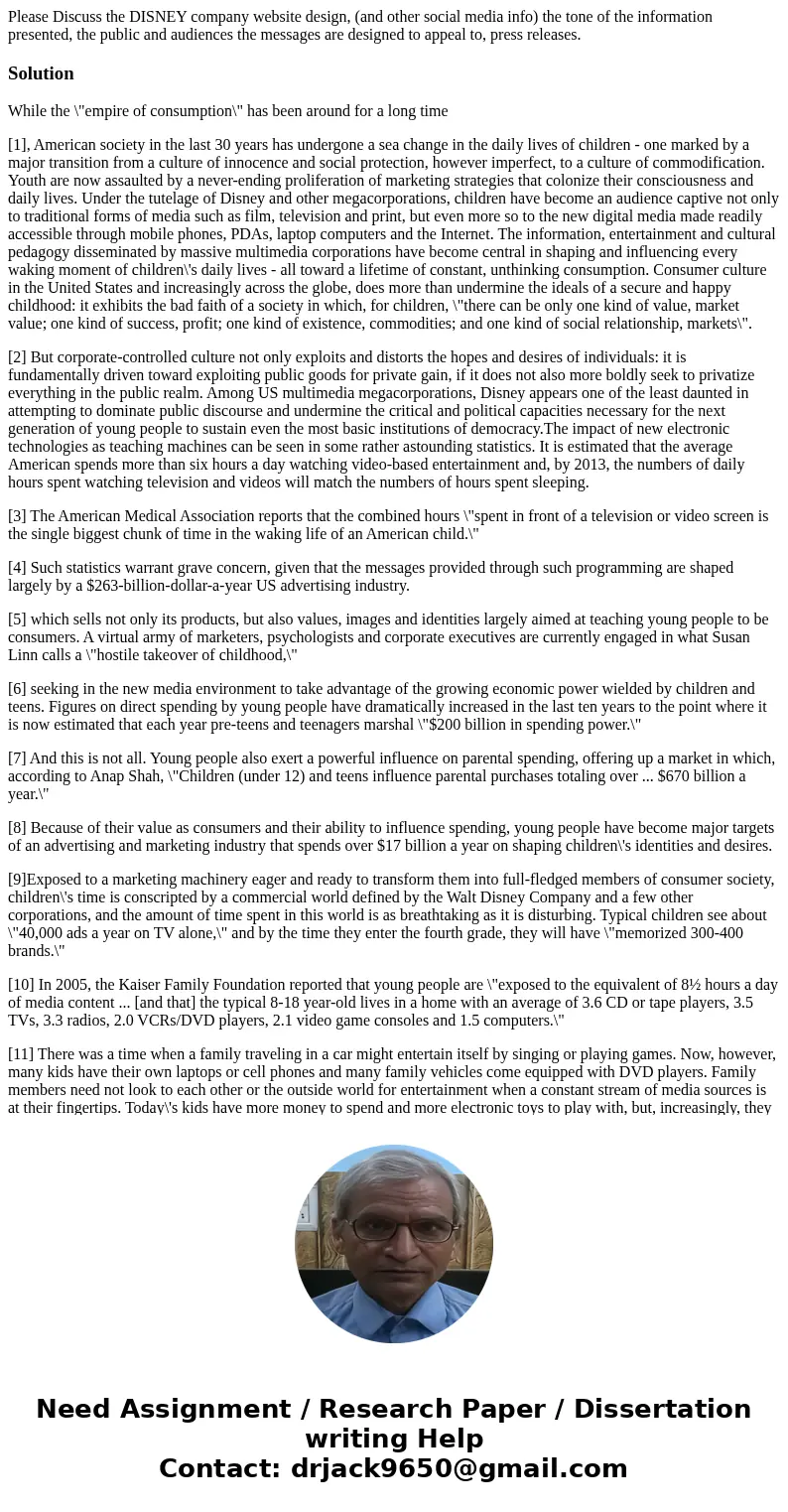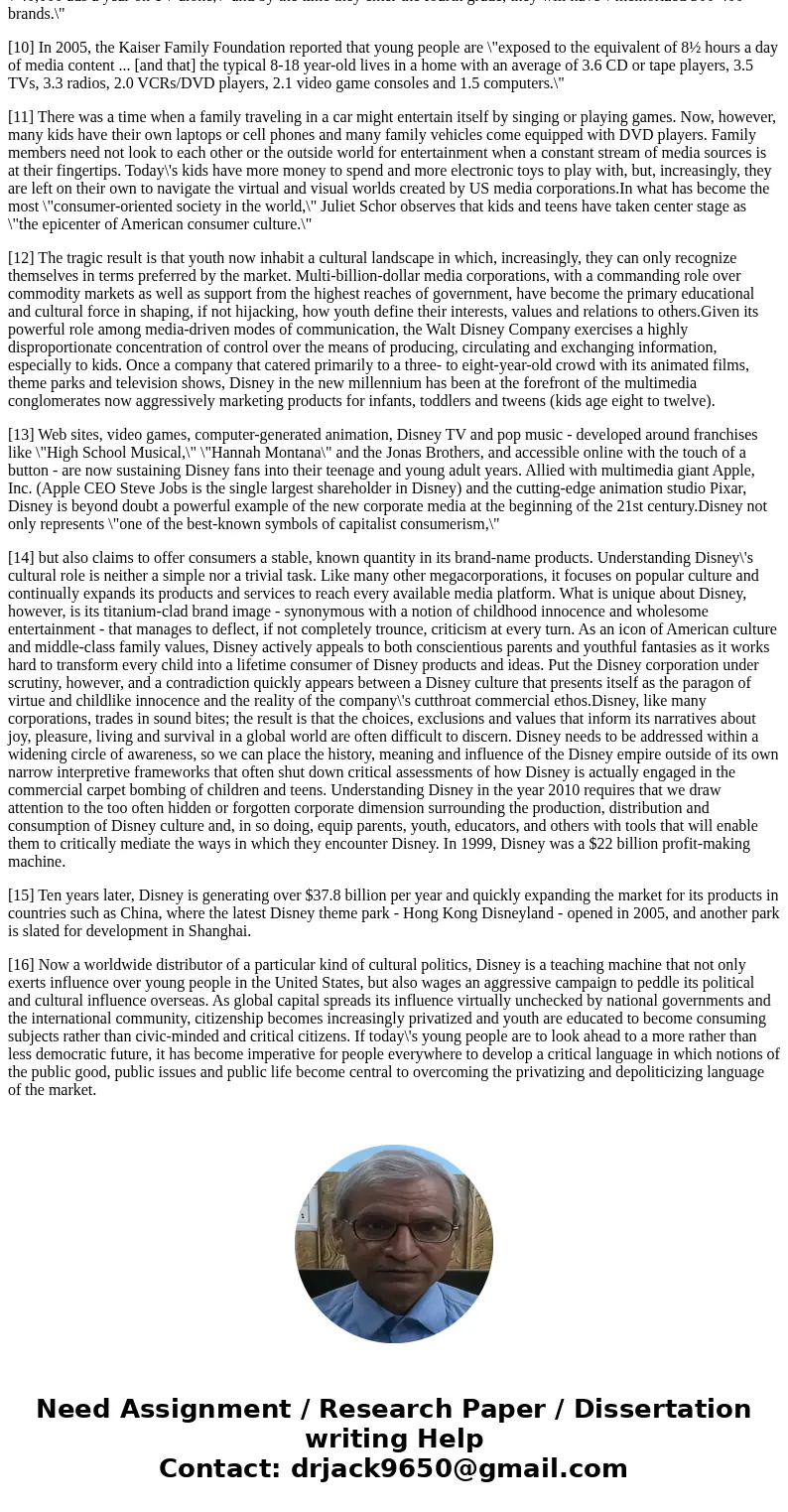Please Discuss the DISNEY company website design and other s
Please Discuss the DISNEY company website design, (and other social media info) the tone of the information presented, the public and audiences the messages are designed to appeal to, press releases.
Solution
While the \"empire of consumption\" has been around for a long time
[1], American society in the last 30 years has undergone a sea change in the daily lives of children - one marked by a major transition from a culture of innocence and social protection, however imperfect, to a culture of commodification. Youth are now assaulted by a never-ending proliferation of marketing strategies that colonize their consciousness and daily lives. Under the tutelage of Disney and other megacorporations, children have become an audience captive not only to traditional forms of media such as film, television and print, but even more so to the new digital media made readily accessible through mobile phones, PDAs, laptop computers and the Internet. The information, entertainment and cultural pedagogy disseminated by massive multimedia corporations have become central in shaping and influencing every waking moment of children\'s daily lives - all toward a lifetime of constant, unthinking consumption. Consumer culture in the United States and increasingly across the globe, does more than undermine the ideals of a secure and happy childhood: it exhibits the bad faith of a society in which, for children, \"there can be only one kind of value, market value; one kind of success, profit; one kind of existence, commodities; and one kind of social relationship, markets\".
[2] But corporate-controlled culture not only exploits and distorts the hopes and desires of individuals: it is fundamentally driven toward exploiting public goods for private gain, if it does not also more boldly seek to privatize everything in the public realm. Among US multimedia megacorporations, Disney appears one of the least daunted in attempting to dominate public discourse and undermine the critical and political capacities necessary for the next generation of young people to sustain even the most basic institutions of democracy.The impact of new electronic technologies as teaching machines can be seen in some rather astounding statistics. It is estimated that the average American spends more than six hours a day watching video-based entertainment and, by 2013, the numbers of daily hours spent watching television and videos will match the numbers of hours spent sleeping.
[3] The American Medical Association reports that the combined hours \"spent in front of a television or video screen is the single biggest chunk of time in the waking life of an American child.\"
[4] Such statistics warrant grave concern, given that the messages provided through such programming are shaped largely by a $263-billion-dollar-a-year US advertising industry.
[5] which sells not only its products, but also values, images and identities largely aimed at teaching young people to be consumers. A virtual army of marketers, psychologists and corporate executives are currently engaged in what Susan Linn calls a \"hostile takeover of childhood,\"
[6] seeking in the new media environment to take advantage of the growing economic power wielded by children and teens. Figures on direct spending by young people have dramatically increased in the last ten years to the point where it is now estimated that each year pre-teens and teenagers marshal \"$200 billion in spending power.\"
[7] And this is not all. Young people also exert a powerful influence on parental spending, offering up a market in which, according to Anap Shah, \"Children (under 12) and teens influence parental purchases totaling over ... $670 billion a year.\"
[8] Because of their value as consumers and their ability to influence spending, young people have become major targets of an advertising and marketing industry that spends over $17 billion a year on shaping children\'s identities and desires.
[9]Exposed to a marketing machinery eager and ready to transform them into full-fledged members of consumer society, children\'s time is conscripted by a commercial world defined by the Walt Disney Company and a few other corporations, and the amount of time spent in this world is as breathtaking as it is disturbing. Typical children see about \"40,000 ads a year on TV alone,\" and by the time they enter the fourth grade, they will have \"memorized 300-400 brands.\"
[10] In 2005, the Kaiser Family Foundation reported that young people are \"exposed to the equivalent of 8½ hours a day of media content ... [and that] the typical 8-18 year-old lives in a home with an average of 3.6 CD or tape players, 3.5 TVs, 3.3 radios, 2.0 VCRs/DVD players, 2.1 video game consoles and 1.5 computers.\"
[11] There was a time when a family traveling in a car might entertain itself by singing or playing games. Now, however, many kids have their own laptops or cell phones and many family vehicles come equipped with DVD players. Family members need not look to each other or the outside world for entertainment when a constant stream of media sources is at their fingertips. Today\'s kids have more money to spend and more electronic toys to play with, but, increasingly, they are left on their own to navigate the virtual and visual worlds created by US media corporations.In what has become the most \"consumer-oriented society in the world,\" Juliet Schor observes that kids and teens have taken center stage as \"the epicenter of American consumer culture.\"
[12] The tragic result is that youth now inhabit a cultural landscape in which, increasingly, they can only recognize themselves in terms preferred by the market. Multi-billion-dollar media corporations, with a commanding role over commodity markets as well as support from the highest reaches of government, have become the primary educational and cultural force in shaping, if not hijacking, how youth define their interests, values and relations to others.Given its powerful role among media-driven modes of communication, the Walt Disney Company exercises a highly disproportionate concentration of control over the means of producing, circulating and exchanging information, especially to kids. Once a company that catered primarily to a three- to eight-year-old crowd with its animated films, theme parks and television shows, Disney in the new millennium has been at the forefront of the multimedia conglomerates now aggressively marketing products for infants, toddlers and tweens (kids age eight to twelve).
[13] Web sites, video games, computer-generated animation, Disney TV and pop music - developed around franchises like \"High School Musical,\" \"Hannah Montana\" and the Jonas Brothers, and accessible online with the touch of a button - are now sustaining Disney fans into their teenage and young adult years. Allied with multimedia giant Apple, Inc. (Apple CEO Steve Jobs is the single largest shareholder in Disney) and the cutting-edge animation studio Pixar, Disney is beyond doubt a powerful example of the new corporate media at the beginning of the 21st century.Disney not only represents \"one of the best-known symbols of capitalist consumerism,\"
[14] but also claims to offer consumers a stable, known quantity in its brand-name products. Understanding Disney\'s cultural role is neither a simple nor a trivial task. Like many other megacorporations, it focuses on popular culture and continually expands its products and services to reach every available media platform. What is unique about Disney, however, is its titanium-clad brand image - synonymous with a notion of childhood innocence and wholesome entertainment - that manages to deflect, if not completely trounce, criticism at every turn. As an icon of American culture and middle-class family values, Disney actively appeals to both conscientious parents and youthful fantasies as it works hard to transform every child into a lifetime consumer of Disney products and ideas. Put the Disney corporation under scrutiny, however, and a contradiction quickly appears between a Disney culture that presents itself as the paragon of virtue and childlike innocence and the reality of the company\'s cutthroat commercial ethos.Disney, like many corporations, trades in sound bites; the result is that the choices, exclusions and values that inform its narratives about joy, pleasure, living and survival in a global world are often difficult to discern. Disney needs to be addressed within a widening circle of awareness, so we can place the history, meaning and influence of the Disney empire outside of its own narrow interpretive frameworks that often shut down critical assessments of how Disney is actually engaged in the commercial carpet bombing of children and teens. Understanding Disney in the year 2010 requires that we draw attention to the too often hidden or forgotten corporate dimension surrounding the production, distribution and consumption of Disney culture and, in so doing, equip parents, youth, educators, and others with tools that will enable them to critically mediate the ways in which they encounter Disney. In 1999, Disney was a $22 billion profit-making machine.
[15] Ten years later, Disney is generating over $37.8 billion per year and quickly expanding the market for its products in countries such as China, where the latest Disney theme park - Hong Kong Disneyland - opened in 2005, and another park is slated for development in Shanghai.
[16] Now a worldwide distributor of a particular kind of cultural politics, Disney is a teaching machine that not only exerts influence over young people in the United States, but also wages an aggressive campaign to peddle its political and cultural influence overseas. As global capital spreads its influence virtually unchecked by national governments and the international community, citizenship becomes increasingly privatized and youth are educated to become consuming subjects rather than civic-minded and critical citizens. If today\'s young people are to look ahead to a more rather than less democratic future, it has become imperative for people everywhere to develop a critical language in which notions of the public good, public issues and public life become central to overcoming the privatizing and depoliticizing language of the market.


 Homework Sourse
Homework Sourse